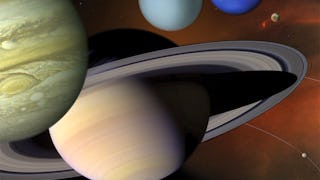In this MOOC, you will have the opportunity to practice several methods of detection and characterisation of exoplanets.
Unlock access to 10,000+ courses with Coursera Plus. Start 7-Day free trial.


您将学到什么
You will explore the different ways of detecting and characterising exoplanets.
You will learn about the physics of atmospheres, which is the key to discovering possible extraterrestrial life.
You will get an overview of future space projects and missions in the field of exoplanets.
您将获得的技能
要了解的详细信息

添加到您的领英档案
7 项作业
了解顶级公司的员工如何掌握热门技能

该课程共有7个模块
If you want to talk about exoplanets, there is no miracle, you have to go through the fundamentals of astrophysics. This is why we propose that you first approach astrophysics from a more historical and fundamental point of view. How did the representation of the universe evolve? How was the modern vision of "celestial mechanics" constructed? You will have the pleasure of discovering the answers to some of these questions. However, in order to go further in this course, we will also see Kepler's three laws as well as some basic notions about protoplanetary disks, planets or star formation. In this first module, we propose to lay the foundations necessary to deal with the concept that interests us all: exoplanets.
涵盖的内容
10个视频2篇阅读材料1个作业
In this second module we will focus on the detection of exoplanets. Together we will discover three methods for detecting extrasolar planets. (1) Radial velocities, which allowed the first detections of hot Jupiters. (2) Astrometry, a method that the Gaia satellite has greatly contributed to boosting. (3) Direct imaging, the only way to really see planetary companions. Don't be scared off by the mathematical approach used to describe these methods. A general understanding is sufficient to follow the next few weeks of the course.
涵盖的内容
7个视频1篇阅读材料1个作业
For this third module, we remain in planet detection. However, this time we will explore the specific case of a planet being seen nearly edge-on and transiting its star. The observation of exoplanet eclipses (transits and occultations) provides us with a wealth of parameters and is currently the most powerful technique to study the structure and other intrinsic properties of planets. In this module, you will therefore have the opportunity to discover mainly how to apply the transit method, but also, at the end of the module, the main outcomes that have been obtained through the use of the transit method.
涵盖的内容
12个视频2篇阅读材料1个作业
Now let's dive into statistics! In this module, we will be interested in the statistical properties of planetary systems. We have chosen to use a chronological approach to do so. First of all, you will discover the first results of the radial velocity programs which unveiled the great diversity of planetary systems. We will then compare these results with those obtained more recently by the transit surveys and the most recent radial velocity surveys. The statistical results of these research programs have brought to light a multiplicity of discoveries around exoplanets. You will have the pleasure of discovering them throughout this module.
涵盖的内容
8个视频1篇阅读材料1个作业
For this fifth module, let's continue our exploration of statistical methods! We will continue to discover the properties of the exoplanetary systems that have been detected so far. You will have the opportunity to understand the link between the properties of the planets and the mass of the central star. We will also see in more detail the dynamics of multiplanetary systems, how planet-planet interactions are translated and, in particular, what are the parameters that influence the stability of systems.
涵盖的内容
8个视频1篇阅读材料1个作业
Let us leave now the statistical analyses to go and look at the properties of the surfaces and atmospheres of exoplanets. In the previous modules, we have seen that radial velocity measurements combined with transits observations allow us to have access to the average density of exoplanets. We could thus put some constraints on the internal structure of the objects. Although only a few very specific systems (young and massive planets with large separation) have been imaged so far, spectroscopic measurements and subtle strategies of observation of transiting and non-transiting systems allow us to know the characteristics of planetary surfaces and atmospheres. This is all we will see together for this penultimate module.
涵盖的内容
12个视频1篇阅读材料1个作业
For this last part of the course, let's continue and complete our exploration of the atmospheres of exoplanets. This module is in fact an update of the course. It integrates the new insights obtained on exoplanet atmospheres since 2014 (date of the first edition of this MOOC). Actually, the content of these last videos is very close to what you would get if you were attending a review on the subject at a real scientific conference. We hope you will enjoy this journey through the different layers of the atmosphere of exoplanets!
涵盖的内容
8个视频1篇阅读材料1个作业
位教师



从 Physics and Astronomy 浏览更多内容
 状态:预览
状态:预览University of Arizona
 状态:预览
状态:预览Caltech
 状态:预览
状态:预览American Museum of Natural History
 状态:预览
状态:预览University of Arizona
人们为什么选择 Coursera 来帮助自己实现职业发展




学生评论
38 条评论
- 5 stars
78.94%
- 4 stars
13.15%
- 3 stars
5.26%
- 2 stars
2.63%
- 1 star
0%
显示 3/38 个
已于 Jun 16, 2024审阅
I have learned how to detect and characterize exoplanets. I had some difficulty understanding some words because of the accents but it does not keep me from understanding the lecture and material.
已于 Nov 16, 2022审阅
An extremely Interesting course with great lecturers, who are at the forefront of the subject
已于 Jul 20, 2024审阅
I love class like this . I have learn a lot. about exoplanets
常见问题
dwkmdwk
To access the course materials, assignments and to earn a Certificate, you will need to purchase the Certificate experience when you enroll in a course. You can try a Free Trial instead, or apply for Financial Aid. The course may offer 'Full Course, No Certificate' instead. This option lets you see all course materials, submit required assessments, and get a final grade. This also means that you will not be able to purchase a Certificate experience.
When you purchase a Certificate you get access to all course materials, including graded assignments. Upon completing the course, your electronic Certificate will be added to your Accomplishments page - from there, you can print your Certificate or add it to your LinkedIn profile.
更多问题
提供助学金,









